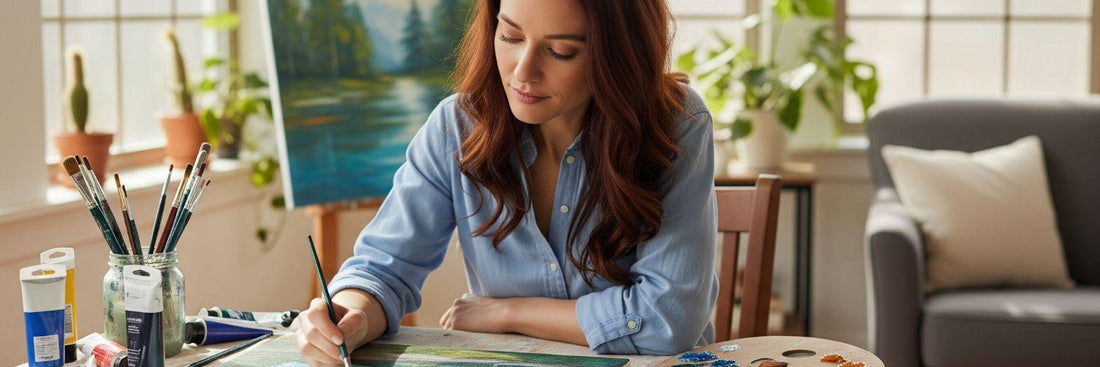In the whirlwind of modern life, women often juggle multiple roles, responsibilities, and expectations, leading to heightened stress levels. Finding effective and accessible methods for self-care is not just a luxury, but a necessity for mental, emotional, and physical well-being. While various stress-relief strategies exist, the ancient and ever-evolving practice of painting offers a unique and profound pathway to tranquility. This guide delves into the therapeutic benefits of painting for stress relief, exploring how this creative pursuit can become a powerful tool in your self-care arsenal.
The act of creating art, particularly painting, provides a sanctuary from daily pressures, allowing for expression, mindfulness, and a deep connection with one's inner self. It's not about producing a masterpiece, but about embracing the process, the colors, and the strokes. Whether you're a seasoned artist or have never picked up a brush, the journey of painting for stress relief is open to everyone.

The Therapeutic Power of Painting for Stress Relief
Art therapy, encompassing various modalities including painting, has long been recognized for its potential to foster healing and well-being. Research consistently highlights the positive impact of engaging with the arts on psychological symptoms, affect, and behavior. A comprehensive scoping review of integrated arts therapies and neuroscience research noted that such modalities can lead to improvements in brain activity and integration, cognitive, affective, sensory, and social functioning, as well as memory reconsolidation [4]. This wide range of benefits underscores why painting can be a powerful tool for managing stress.
Beyond general psychological improvements, specific studies have demonstrated the efficacy of art therapy in enhancing quality of life and reducing fatigue. For instance, a meta-analysis focusing on breast cancer patients indicated that art therapy significantly improved their quality of life [5]. While this study focused on a specific patient group, the underlying mechanisms of art's positive influence on well-being are broadly applicable to anyone seeking stress relief and an improved sense of calm.
Understanding the Mechanisms: How Painting Calms the Mind
The calming effects of painting for stress relief stem from several interconnected psychological and physiological mechanisms. Engaging with paint and art materials activates different parts of the brain, promoting a state of focused attention that can be deeply restorative.
Embodied Cognition and Self-Expression
The process of painting is not merely a visual activity; it involves a profound form of "Material Thinking" and embodied cognition. Even in individuals with cognitive decline, such as those living with dementia, the act of painting has been shown to involve distinct forms of decision-making, agency, and cognition [1]. This highlights how painting engages our inherent capacity for expression and problem-solving, regardless of verbal abilities. For women navigating stress, this means painting can provide a non-verbal outlet for emotions, thoughts, and experiences that might be difficult to articulate otherwise. The decisions made with each brushstroke—choosing a color, determining pressure, or blending hues—are small acts of agency that can foster a sense of control and accomplishment, counteracting feelings of helplessness often associated with stress.
The tactile nature of painting, the feel of the brush on canvas, the texture of the paint, and the visual feedback of colors mixing and forming shapes, create a sensory experience that grounds individuals in the present moment. This immersion, often referred to as a "flow state," allows the mind to quiet the incessant chatter of worries and anxieties, leading to profound relaxation.
Visual Immersion and Nature's Influence
Beyond the act of creation, the visual aspect of painting itself holds significant stress-reducing potential. A comparative experimental study explored stress reduction from viewing landscape paintings versus live nature. The findings revealed that viewing landscape paintings led to stress reduction of comparable statistical magnitude to viewing live nature, and even a faster rate of stress reduction during gallery viewing [6]. This suggests that visual engagement with art, especially naturalistic or calming imagery, can directly impact physiological arousal and promote a sense of calm.
When you engage in painting for stress relief, you are not only creating art but also immersing yourself in a visually stimulating and potentially calming environment. By choosing to paint landscapes, seascapes, or abstract interpretations of nature, you can harness this inherent human connection to natural beauty, even if you are painting indoors. The colors, forms, and compositions can evoke feelings of peace and serenity, further enhancing the stress-relieving experience.
Practical Painting Techniques for Stress Relief
To maximize the benefits of painting for stress relief, focus on the process rather than the outcome. Here are some painting techniques for stress relief that can help you unwind and express yourself:
- Abstract Expressionism: Don't worry about painting something recognizable. Instead, focus on the movement of your hand, the colors you choose, and the emotions you want to express. Use broad strokes, splatter paint, or mix colors directly on the canvas. This technique is incredibly liberating and allows for pure emotional release.
- Mindful Painting: Approach each brushstroke with intention and awareness. Pay attention to your breath as you paint. Notice the texture of the paint, the sound of the brush, and the way colors interact. This practice transforms painting into a meditation, anchoring you firmly in the present moment and quieting the mind.
- Nature-Inspired Painting: Drawing inspiration from the study on landscape viewing [6], try painting elements from nature. This could be a simplified landscape, a single flower, or even just the colors you associate with a serene natural scene. Connecting with nature through art can be deeply grounding.
- Intuitive Painting: Let go of all rules and expectations. Allow your intuition to guide your hand. Pick colors that call to you, make marks without a plan, and see what emerges. This technique encourages spontaneity and helps quiet the inner critic, fostering a sense of freedom.
- Color Therapy through Painting: Explore the psychological effects of different colors. Use warm colors (reds, oranges, yellows) to evoke energy and passion, or cool colors (blues, greens, purples) for calm and serenity. Experiment with how different palettes make you feel as you paint.
Painting as a Hobby for Sustained Well-being
Embracing painting as a hobby for stress relief extends beyond single sessions; it offers a pathway to sustained well-being. Integrating a creative practice into your routine provides a consistent outlet for expression and relaxation, fostering resilience against daily stressors.
Making painting a regular part of your life can create a ritual of self-care. This dedicated time signals to your mind and body that it's time to slow down, focus inward, and engage in an activity purely for pleasure and personal growth. Over time, this consistency can lead to improved mood regulation, increased self-awareness, and a greater sense of accomplishment.
Consider joining a local art class or workshop. This not only provides structured guidance on painting techniques for stress relief but also offers a sense of community. Sharing your creative journey with others can be incredibly supportive and inspiring, reducing feelings of isolation and fostering new connections. Even if you prefer to paint alone, dedicating a small corner of your home as a creative space can signal to your brain that it's time to enter a state of flow and relaxation.
One of the biggest challenges in embracing painting as a hobby is often the fear of not being "good enough." It's crucial to remember that painting for stress relief is about the journey, not the destination. Release the pressure to create perfect art. Embrace imperfections, see them as part of the unique character of your work, and celebrate the act of creation itself. This shift in mindset is key to unlocking the full stress-relieving potential of painting.
Getting Started: Your Journey to Creative Calm
Starting your journey with painting for stress relief doesn't require a significant investment or prior experience. Here's how you can begin:
- Gather Simple Materials: You don't need an elaborate setup. A basic set of watercolor paints, a few brushes, and some paper are more than enough to start. Acrylics are also a great option as they dry quickly and are easy to clean up.
- Find Your Space: Designate a quiet corner where you can paint without interruption. Even a kitchen table can become your temporary studio. The key is to create a space where you feel comfortable and can focus.
- Set Aside Time: Even 15-30 minutes a few times a week can make a difference. Consistency is more important than duration. Treat this time as a non-negotiable appointment with yourself.
- Embrace Experimentation: Don't be afraid to try different colors, textures, and painting techniques for stress relief. There's no right or wrong way to paint for relaxation. Let curiosity guide you.
- Let Go of Perfectionism: This is perhaps the most important tip. The goal is not to create a masterpiece, but to enjoy the process, express yourself, and find calm. Your painting is a reflection of your journey, not a test of your artistic skill.
In a world that often demands so much, painting offers a gentle yet powerful way for women to reclaim their peace, express their inner landscape, and find profound stress relief. By embracing this creative journey, you're not just learning to paint; you're learning to nurture your soul.






